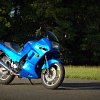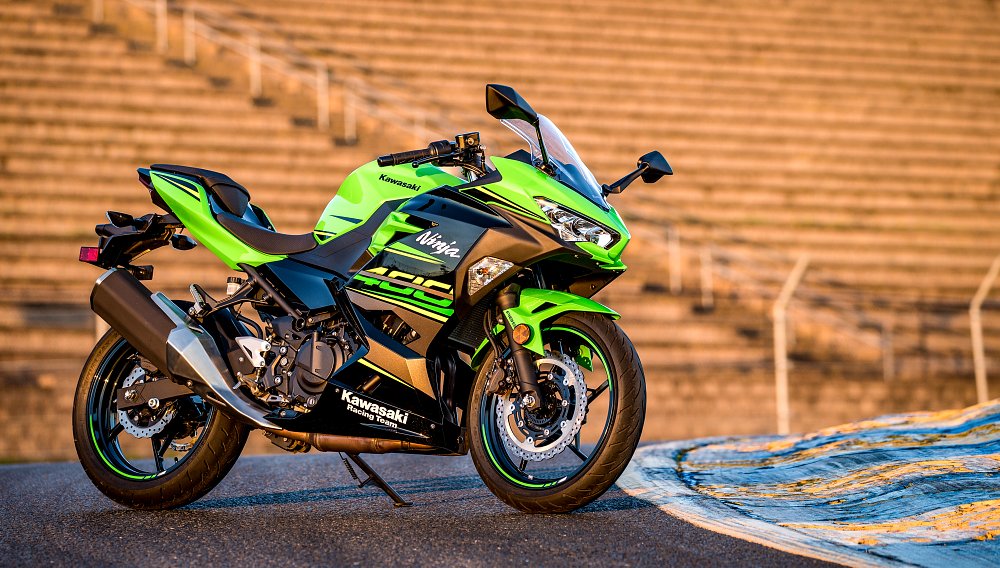The last time I rode a Ninja 250 was the summer of 2011. A friend had purchased one as a first bike and asked me to get it home. Now, a decade later, one rolled into my shop once again and I had to stop and reminisce a bit.
This specific motorcycle is a 2007 Kawasaki EX250 (known as the Ninja 250R, ZX-250, and GPZ-250 among other things). Today, it’s 14 years old and two generations behind the smallest baby Ninja that Team Green offers, and Kawasaki has been steadily improving their entry model. Common Tread wasn’t even born when this noughties-era boxy-butted beauty rolled off the line. Hardly worth spilling any digital ink on it, right?
Not so fast. My friend wasn’t the only one inducted into the world of motorcycling by a Ninja 250. Uncounted thousands of riders got started on these bikes. This is a used motorcycle that might be considered by riders ranging from a vet building a track-day rig to a first-season rider coming off a Z125 Pro. It’s natural to ask if the 250 is still relevant. Does the Pope wear a funny hat?

I turned my eye on my newest used bike the same way I’d review a new motorcycle for Common Tread.
What $2,999 gets you these days
That was the MSRP on a new Ninja in 2007. Thanks to skyrocketing used bike prices, that’s also about what you’ll cough up for a real clean one today. To provide a baseline, the base 2021 Ninja 400 retails at $4,999 today. Comparing a nice used bike to a brand new one here, one is likely to draw one of the following conclusions: The two-fiddy is either 1) a much cheaper motorcycle (40 percent less!) that executes well in the same roles as the ‘21 version or 2) an awful choice because it lacks 150 cc, a slipper clutch, fuel injection, optional ABS and 17-inch wheels.
Why mention price first? Well, if one is considering a used bike, it’s probably an important consideration. Further, new bikes are in short supply these days, so some riders who are looking for a new machine have to look downmarket.
Getting reacquainted with the Ninja 250
When I first walked up to this little blast from the past some 10 years after the last time I rode one, a few things jumped out before I even fired up the motorcycle.
Normally I don’t have a lot to say about styling, but let’s be frank: This bike now looks dated. That big rectangular rear and the long, slab-sided cowling that was the hallmark of early Ninjas is still distinctive, but it’s almost edging into accidentally retro-cool. This early sport bike sculpting directly impacts something else: the width of this package. The new Ninja 400 is definitely wasp-waisted, but the fuel tank is big and bulbous at the top, making it seem more substantial than it really is. By contrast, the ‘80s sport bike tank atop the Bebbeh Ninja has sides that are fairly straight-walled.

The result? The EX250 feels diminutive, even in comparison with a modern 400. It is short in height, short in wheelbase, and very, very narrow. When you pick it off its teeny little sidestand, its feather-like weight also becomes apparent: 374 pounds wet. That’s four pounds heavier than the modern Ninja which, unlike the OG, does not have a centerstand. I can’t speak for you, but I’ll eat a four-pound penalty if I get a centerstand outta the deal.
Other things jump out to me when I think about this machine in the context of a Gen Z rider. I turned over the keys to my boy, who was promptly stranded on his first ride because he did not know how to find or operate the petcock. (He also quickly learned how one checks the fuel level on a machine without a fuel gauge!)

To wake up the littlest (American) Ninja, one must use copious amounts of choke, conveniently located on the left grip. (Early Ninjas were and are notoriously hard-starting due to the lean pilot circuit.) None of this is foreign to me, but as I age, I have watched more and more young riders struggle with these things. It works as the factory intended, but could still turn off potential purchasers before the wheels ever turn. Time’s a funny thing.
Once the motorcycle warmed up, it really narrowed the gap with modern competition. There’s no slipper clutch, but the clutch is super-light. So is the throttle return spring. They’re both perfect for new riders who need to master the requisite fine motor control skills for safe motorcycle operation. At speed, the Ninja is light and flickable, and the 29.3-inch seat height is certainly approachable.
The engine is an unpretentious, diligent worker. It’s a dual-overhead cam parallel twin with a 13,000 rpm redline (14,000 for pre-’05 models.) A 12.4:1 compression ratio certainly squeezes the air-fuel charge, but regular ol’ 87 octane is fine for fillups. The cylinder head houses screw-type lash adjusters for simple, cheap valve checks and adjustments.
It doesn’t have the pop and sizzle the 400 has, but it’s close. The engine will happily sing its heart out and really rewards rpm management. The 400 forgives the mortal sins one may commit atop smallbores: incorrect gear choice and failure to maintain momentum. The 250 shows much less leniency. Still, it is not slow; at 265 pounds, I easily buzzed along at an indicated 90 mph aboard the 250, and triple digits are probably on the table. (I didn’t try.)

That power is routed through a six-speed transmission. Sixth is not too tall. (I think it often is on small-displacement machines. The smart ratios are in part what deliver the strong pull up to supra-legal speeds.) The trans has an interesting feature: Kawasaki’s own Positive Neutral Finder. When stopped, second gear is locked out. Simply yank the shift lever upwards in first, and you’ve got immediate access to neutral without the prospect of going too far and winding up in second. It works flawlessly on our test bike. It’s a neat addition to such an otherwise-spartan motorcycle, and it probably should not be overlooked as a boon for rookies.
Brakes are so-so by 2021 standards, which means they were so-so by 2007 standards, too. They’re budget-spec, but the package's light weight means a single disc on each wheel is adequate. Suspension, on the other hand, is miserable. The whole machine is undersprung for normally sized adults. The right-side-up fork’s damping somehow manages to be wallowy on low-speed compression, yet harsh during high-speed cycling. It’s a budget bike. You get what you paid for. The suspension hindered my ability to carry momentum through turns. On the upside, the diving fork was so bad it kept me off the brakes. Carrying speed is critical with smallbores, but you can’t do that if the tires aren’t in contact with the road.

There’s not a lot to write about from the cockpit. The seat is wide and soft. It’s really a phenomenal stock seat, which is great, because the aftermarket for these motorcycles has always been anemic. Wind protection is a pipe dream. I was maybe a touch cramped on this motorcycle, but it’s nothing like the body-twisting that race reps farther up the food chain put me through. I’d also be remiss if I failed to mention those integrated luggage hooks! Dorky? Sure, but they work. A fuel gauge would be nice, I guess. Maybe I’m getting soft as I age.
All in all, I am still in love with these little things. The Ninja rewards conscientious pilots and is built tough enough to take the beating and abuse that comes with that riding style.

So if the 250 still matters, who should buy it?
I’ve relaxed my stance on the Ninja 400 a bit, I suppose. I still want a ZX-25R. Sadly for me, most people in North America do not feel the same way. Operating under the assumption that we’ll never see that machine on our shores, one is limited to the 250, 300, and 400 Ninjas, all twins. The 400 is objectively the best of the breed, though I’m not convinced the added displacement is equivalent to added value. The better brakes, suspension, and chassis, however, sure are.
For newer riders, the 250 is still the dirt-cheap crasher option, but I think after watching my boy struggle with a few things on this machine, he might be better served by a newer 300 or 400. ABS isn’t a big deal to me at this late date in my riding career, but it’s cheap insurance for a recent licensee. Choosing from the wider crop of 17-inch rubber nowadays will be a notable boon for both rookies and seasoned riders who keep a quarter-liter in the stable. This Ninja 250 is not the best option for a newer rider, but if money is tight, the 250 could be the difference between having and hoping.

But the 250 is a great choice for experienced motorcyclists. Some experienced riders choose one of these for track days because the 250 practically forces you to use good riding technique if you want to keep up. If you blow a shift, miss an apex or get a lousy drive out of the corner, the additional power of the 400 might help cover up your sins (though not as much as the stereotypical track-day rider on a liter bike who blasts past on the straights and parks it in the corners), while the 250 just falls on its face. Beginners aren't the only ones who can learn something from riding the 250.
Back on the street, the 250’s reduced power also means every commute to work becomes a full-throttle scrape sesh without really flagrantly breaking many laws. The 250 can be acquired more affordably than a new bike, leaving money for the suspension upgrade you'll probably want. If you don’t mind a ratty one, $1,500 two-fiddies exist in the wild. The 400 isn’t old enough to be that cheap just yet.
Because so many were “first-season-and-sell” acquisitions, they can be found with light cosmetic damage and low mileage. Turning on the fuel and opening the tank to see how much is in there isn’t really too much to ask for a healthy discount from more modern mounts.

The verdict on the Ninja 250
Most of my acquisitions these days are flip victims. This one could end up that way… but maybe not. I bought it because it was in uncommonly good shape and there’s room to extract a few dollars out of it. But it’s pretty fun to ride to work. And my congenitally cheapass progeny has been eyeing it. And the thought of a fork swap has certainly crossed my mind. The motorcycle is very flexible, and because of that, there are a lot of use cases where it could serve admirably.
The 250 Ninja is still simple and fun. If you can find a twisty enough road, you can blow off larger displacement motorcycles. Sixteen dollars will cover liability insurance for a month, as well as a tank of gas, which should last almost as long. Even if you find the nicest one in the world, the price will be so low you can’t get financing through traditional channels.
I’m trying to think of who I might chastise for buying one of these, and I’m coming up short. That’s a pretty glowing review for this pretty old bike.

















